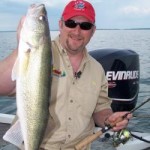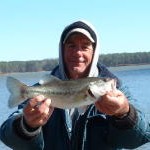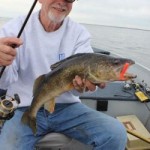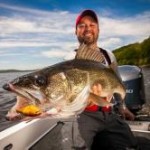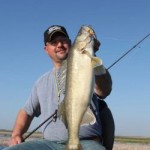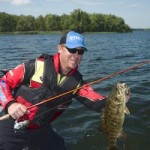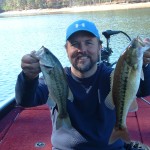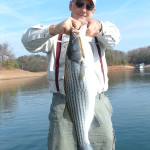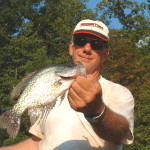
I caught this crappie in my pond
Beating The Summer Fishing Doldrums In Georgia
September can be our meanest month for fishing. Early in the month water temperatures are as high as they get all year. Oxygen content is as low as it gets, with a thermocline just a few feet down in many lakes and ponds. Water levels are usually dropping. And fish have been hit hard all summer, to the point it seems they can quote the price of popular lures.
The good thing about September fishing in Georgia is things will get much better toward its end, but there is no need to stay home and wait. Many places around out state offer good fishing even now, and you can catch a wide variety of kinds of fish in many different kinds of waters.
If you are ready to give up and stay home until things cool down, consider these places for a trip right now.
Lake Andrews Catfish
Like big catfish? Or just want a good mess of eating size fish? Lake Andrews offers both, and you can do well there now. You can catch blues, channels and flatheads from the lake.
Andrews is a small 801 acre lake on the Chattahoochee River that backs up to the Walter F. George dam. There is a lot of current in the lake due to discharges at the George dam, and current keeps the oxygen content higher and makes fish feed. Six boat ramps give good access to the lake, and a boat is the best way to fish for catfish.
How big are the cats in Andrews? The current state record 80 pound, 4 ounce blue cat was caught there in February, 2010. In 2006 it produced a state record at that time of 67 pounds, 8 ounces. If a big blue is what you want Andrews is a good place to find it.
The waters just below the Walter F. George dam as well as below the Andrew dam are good places for big cats. Anchor so you can fish the seams of current from normal discharge or power generation from the dam.
For the big blue cats fish cut gizzard or threadfin shad. Big baits catch big cats, so don’t hesitate to use a whole gizzard shad eight to ten inches long. Big flatheads like live bait so try a live bream, sucker or shad for them.
For eating size blues in the one to four pound range, which are common in the lake, try smaller pieces of cut gizzard shad or whole threadfin shad. Also try earthworms and bloodbaits for them and channel cats. Night fishing is best this time of year. Anchor your boat at deep holes near shallow water and fish the hole as well as the lip of the more shallow water around it.
For smaller flatheads try small live bream or shad and crayfish. The same deep holes will harbor flatheads. You can also catch smaller cats near the dams is areas with less current, so let your baits drift into eddies and other current breaks.
Flint River Shoal Bass
The Flint River offers fun fishing for shoal bass in September and much of it will be wading, so you can stay cool and comfortable while catching fish. The river from the Lake Blackshear dam to the Highway 32 Bridge offers a solid day’s fishing trip. You can launch a boat below the dam and take out at the bridge.
This section of the river is beautiful, with cypress trees and wildlife on both banks. It is very wild, with only a few houses and fields on the river. There are multiple shoals along this section of the river and in September the water is low so expect to get out and push your boat often.
A jon boat with a small gas motor is best since there are some fairly long flat water sections of the river. If you don’t motor through most of these sections you won’t make the trip in one day, and paddling a canoe or kayak is fun but you will do a lot more paddling and less fishing from them. You can camp on sand bars along the river if you want to make this a multiple day trip.
Shoal bass are the main target here although the river has everything from catfish to chain pickerel to warmouth. Shoal bass are first cousins of the smallmouth and are mostly brown with vertical bars. And they fight like a smallmouth, pulling hard, making exciting jumps and not giving up till they are out of the water.
Artificials work well and you can use topwater, crankbaits and plastics. Live bait like spring lizards, crawfish, hellgrammites and minnows will catch the bass, too. Ten pound test line on a spinning rod and reel will help give you the best fight and make throwing smaller baits easier. You will be wading and fishing a good bit so a lighter outfit is easier to handle, too.
In flat water sections of the river cast a small topwater popper or prop bait around blowdowns. Also work a small bream or crawfish colored crankbait like a #5 Shadrap through the limbs of the trees. Follow up with a green pumpkin curly tail worm behind a one-eighth to one-quarter ounce sinker. Go as light as you can based on current.
Let a spring lizard drift into a blowdown on a weedless hook and no sinker and you are almost guaranteed to hook a fish. It is hard to carry enough bait with you, though. You can catch small minnows and crawfish along the way and do the same with them. Also, rock worms or hellgrammites are common along the river and bass love them. Fish them and crayfish suspended under a cork since they will latch onto rocks.
Artificals work better when wading the shoals since you don’t have to carry a lot of bait with you and you can work them more effectively. Anchor your boat at the head of the shoals and fish down one area and back up the other side to the boat. Or, if there are two fishermen, one can start at the head of bigger shoals while the other drifts half way down, leaves the boat and fishes to the end. Just be sure to pick up your partner if you are the first one out, even if he is catching more fish than you!
When wading the shoals target deeper pools and runs between rocks. Hit any eddy behind a rock or log in the shoal. Let a green pumpkin worm drift into the holes and eddies. A light sinker works best. Also run your crankbait with the current through the riffs and into deeper holes.
Alatamaha River Tarpon
The Georgia Coast may seem like a strange place to head when it is so hot, but the fishing will make up for being too warm. There are a variety of good choices on the lower Altamaha River and sound but the most exciting has to be tarpon.
Tarpon migrate north during the summer and hit the Georgia coast in late June most years. There are still large numbers of them around in September. They move into the rivers and feed and you can sight fish for them in the river and the sounds. Hooking a tarpon gives you one of the most thrilling fights in fishing, with water throwing jumps and sizzling runs from fish that can weigh over 100 pounds.
You don’t need really heavy tackle for this kind of fishing. A stout bass flipping stick or heavy freshwater spinning rod to light saltwater outfits you can cast work well. You need a reel that will hold a good amount of twenty to thirty pound test line. That is strong enough but you need a much heavier leader to keep the fish from cutting the line.
Net live menhaden, also called “pogies,” or catch some cigar mullet about 12 inches long for bait and cast them ahead of surfacing tarpon for thrilling sight fishing. Fish them weighless for the best action. You can also get hits on artificials like bucktail jigs and big crankbaits.
Some days the tarpon are very spooky and you can’t approach them very closely, and they will take off when your lure or bait hits near them. On those days or when you don’t see them surfacing and feeding much try drifting live bait anywhere you see signs of tarpon. Put out a pogie on one weightless flat line and a mullet on another and drop one of each baits down on weighed rigs. Offer them a choice but be ready to grab a rod fast when you get a hit.
Lake Thurmond Largemouths
Lake Thurmond, better known as Clarks Hill to Georgia fishermen, is well known for its great bass fishing. It is full of keeper size bass with a good chance of landing a mounting size largemouth. Tournament catches of five fish weighing 15 pounds are common and 20 pound stringers are weighed in often.
September is as tough as it gets on Clarks Hill. During the day you can get on some topwater action as bass smash herring and shad on top but night fishing really shines. You can be comfortable while fishing and catch a lot of bass, too.
Many bass will feed in shallow water right at dark and again at daylight, and some will be active there all night long. Small flats near channel bends in the creeks are best. Deeper structure like rocky points near channels and riprap on bridges is good all night long, too.
Start about an hour before the sun sets with a big buzzbait fished on shady banks. Throw it right on the bank and work it fairly fast back to the boat. Make as long a cast as you can to cover more water. Hydrilla growing in the shallows makes for much better fishing but in some places it can be to thick for a buzzbait. If so, try a popping frog over the hydrilla. Also slow down and fish a big plastic worm.
Fish the same shallows from first light until the sun gets on the water, too. Again stay on the shady side of the bank. Both morning and night try to find some stumps or bushes in the water to fish as well as the hydrilla. The lake has been so low for so long bushes are hard to find now, though.
After full dark Texas rig a black plastic bait behind a three sixteenths ounce lead or use a one eighth ounce jig head with the same worm. Something with curly tails or legs moves more water making it easier for the bass to hone in on them in the dark.
Get on a bridge riprap or rocky point and fish both from the bank to the end and back. On the points keep your boat out in deep water and cast up on top of the point, working the shallow part then down the slope. If you put a bead or two between the lead and worm on your Texas rig you can shake your rod tip and make them click, further attracting the bass.
On riprap keep your boat out in about 20 feet of water and make angle casts, throwing your bait right against the rocks and fishing it slowly all the way back under the boat. Try to hit every rock and twitch your bait in one place. If you are getting hung too much go to a one eighth or even one sixteenth ounce sinker. You will have to work the lighter leads more slowly, but that is a good thing.
Toccoa River Trout
The Toccoa River below Lake Blue Ridge Dam has been a good place to catch rainbows in the past but the drawdown of the lake for dam repair hurt the fishing. The good news is cold water is flowing from the dam again and fishing is good again. In the past two years the DNR and volunteers have released 40,000 brown, rainbow, and brook trout ranging from 3 inches to over 4 pounds in the river.
You will catch a lot of trout in the river between 10 and 14 inches long this fall but you also have a good chance of a big rainbow or brown. Fish from the Blue Ridge dam downstream to Horseshoe Bend Park. Four public access points, at Blue Ridge Dam, Curtis Switch, Tammen and Horseshoe Bend Parks often get crowded but you can float between them in a canoe, kayak or tube and catch fish.
Trout in this section of the river can be anywhere from one side to the other but you will have your best luck near some kind of cover. Fish fast runs, undercut banks, deeper holes and any kind of break in the current like big rocks or wood.
You can use live bait (except live minnows), flies or artificials on this section of the river and all will catch fish. Nightcrawlers are one of the most popular and best baits. Drift a worm weightless through deeper holes for big fish. Also try canned kernel corn. Put it on a bare hook or stick a piece on one of the hooks of a small inline spinner. The corn must look like hatchery food since they like it so much.
You can’t use live minnows but artificials like small crankbaits, inline spinners and spoons will fool trout. Brown trout especially like minnows and these fake minnows are good baits to fool them. Fish them on four to six pound fluorocarbon line on a light spinning outfit.
For fly fishing the Toccoa offers good caddis, mayfly and midge hatches. Carry flies to match the hatch from any of these and you will catch trout. You can also catch good trout on streamers and wet flies. Streamers work well when fished deep in slower water in big pools.
Carters Lake Spotted Bass
Carters Lake has one of the best populations of big spotted bass in the state. Four and five pound spots are common and six to seven pounders are caught every year. The lake is very deep and has shad as well as alewives baitfish that the bass focus on this time of year.
During the day drop live bait, drop shot rigs or spoons down to suspended bass. They will hold under schools of baitfish, often in the tops of standing timber in very deep water. Focus on the main lake and use your deptfinder to locate them.
At night fish a small jig and pig on steep rocky banks near the dam. Also try a big black spinnerbait slow rolled on points and parallel to bluff banks. A little red in the skirt will help. A deep running crankbait will also catch spots in the same places.
These six places around out state give you some good options to beat the September funk and catch fish. Give one or all a try this month and you might not dislike September fishing so much in the future.
